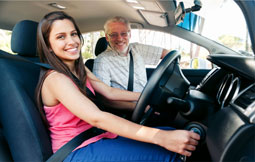24 Pedestrian crossings
![]() There are several types of pedestrian crossings that you may encounter on the test.
There are several types of pedestrian crossings that you may encounter on the test.
What the examiner is looking for
The examiner is checking that you
- Use the MSM routine in good time on approach
- Reduce your speed on approach if people are waiting to cross and you think the lights are about to change to red or that someone may step on to the road or if your view of the crossing is restricted
- Do not beckon anyone to cross
- Slow down and give way to pedestrians already crossing
- Slow down and stop if the lights change to amber and then red
- Slow down and stop if pedestrians are about to cross at a zebra crossing
- Stop behind the designated stop/give way line
- Do not straddle the crossing area when in queues of traffic and keep behind the stop/give way line until it is safe to proceed and sufficient space is available to clear the crossing area
- Do not move off until the lights turn to green and it is safe to do so. Unless on a pelican crossing in which case you can proceed on flashing amber if it is safe to do so
- Do not wait unnecessarily when the amber light at a pelican crossing is flashing and no one else intends to cross in front of you
- Are courteous and patient.
Driving faults recorded
24 Pedestrian crossings:
- Does not reduce speed on the approach when vision is restricted.
- Approaches at too high a speed with pedestrians on crossing.
- Overtaking on zigzag lines on approach.
- Not giving precedence to pedestrians on a crossing.
- Not stopping at give way or stop lines when necessary.
- Not acting in accordance with the traffic lights controlling the crossing.
- Harassing pedestrians.
- Waving pedestrians over a crossing.
- Moving away before pedestrians have crossed over in front of the car.
- Attempting to proceed when unsafe to do so.
- Stopping on the actual crossing.











